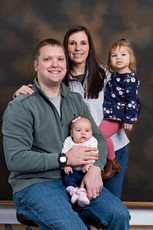Patient Story - Kelsey Weisent
 For many women, childbirth is an exhilarating, challenging experience that demonstrates the function and design of the female body. The labor of bringing a new life into the world and the intimacy of the moment creates a unique bond between mother and child. However, health concerns may necessitate a cesarean section – the surgical delivery of a baby through an incision made in the mother’s abdomen and uterus. Although the procedure may be a necessary intervention, the experience can cause a mother to experience a range of emotions, including fear and sadness about being unable to deliver naturally. Once a woman has had to have a cesarean delivery, it is often advised that all subsequent deliveries be by cesarean due to increased risk of uterine rupture.
For many women, childbirth is an exhilarating, challenging experience that demonstrates the function and design of the female body. The labor of bringing a new life into the world and the intimacy of the moment creates a unique bond between mother and child. However, health concerns may necessitate a cesarean section – the surgical delivery of a baby through an incision made in the mother’s abdomen and uterus. Although the procedure may be a necessary intervention, the experience can cause a mother to experience a range of emotions, including fear and sadness about being unable to deliver naturally. Once a woman has had to have a cesarean delivery, it is often advised that all subsequent deliveries be by cesarean due to increased risk of uterine rupture.
Kelsey Weisent’s first daughter, Emery, was delivered cesarean due to concerning vital signs. Three and a half weeks before her due date, Kelsey’s medical team felt Emery was in distress as her heart rate was dropping. Action was taken to protect the baby’s health.
“The entire experience was overwhelming and left me feeling out of control. I was terrified,” Kelsey remembered. “In the end, I felt like I had missed out on having a natural birth which was something I had envisioned and dreamed of for years.”
When planning for the birth of her second child, Kelsey discussed the possibility of a vaginal birth with her healthcare providers. She discovered that trial of labor after cesarean (TOLAC) is a safe option for delivery under careful assessment and advanced medical care. Women who achieve a vaginal birth after cesarean avoid major abdominal surgery and have lower rates of hemorrhage, thromboembolism, and infection, and a shorter recovery period than women who have an elective repeat cesarean delivery. Kelsey was in good health and deemed to be a good candidate for TOLAC.
“Certified Nurse Midwife Erica Brown explained to me that many healthcare facilities do not offer TOLAC as a choice because a team of experts, including a physician and anesthesiologist, must be present on the Labor and Delivery floor throughout the entire labor process due to the risks. However, I felt TOLAC was the right choice for me,” Kelsey said.
The staff at Licking Memorial Women’s Health and Maternity Services encourage women to take an active role in creating a birth plan by providing a support system and resources that prepare the expecting family for the arrival of their new family member. The patient’s needs and desires are at the forefront of any treatment plan.
“No one ever said that I could not deliver my baby naturally. They discussed my preferences and were considerate of the vision I had for the experience,” Kelsey explained.
Kelsey’s pregnancy was carefully monitored. When she began having contractions late on a December evening, she knew she could labor at home for several hours before heading to Licking Memorial Hospital (LMH). Upon arrival, Kelsey was allowed to choose her preferred method of relaxation and position herself as needed for comfort. The time spent at home had been productive, and her labor was progressing well.
“The nurses were the real champions for me,” Kelsey shared. “They gave valuable coaching advice, explained the details of the next steps, were supportive, and cheered for me as I progressed toward delivery. Every aspect of the experience was my choice. I felt empowered, capable, and excited to achieve the birthing experience I had imagined.”
As the contractions grew stronger, Kelsey was feeling exhausted and did request an epidural – a regional anesthesia that blocks pain in the lower half of the body. The goal of an epidural is to provide analgesia – or pain relief – rather than anesthesia, which leads to a total lack of feeling. Since the labor had already progressed fairly quickly, Kelsey received only minimal pain relief.
“I still felt some of the pain; but, in the end, I was very proud to have endured through the labor and delivery,” Kelsey remarked. “It was a beautiful experience, and I was overjoyed to be able to hold Riley on my chest afterward just as I had dreamed.”
As standard practice at LMH, Kelsey, her husband, Jack, and Riley shared a room for the remainder of their stay. The “rooming-in” model allows parents to bond with their newborn while the professional nursing staff provides support and one-on-one education necessary for a smooth transition home. After a short stay, mother and infant were released to return home and begin life as a family of four.
Both Kelsey and Jack grew up in Newark just a mile apart, but did not meet until they were adults. The couple has been married for four years. Kelsey teaches 4th grade for Newark City Schools. Jack is a nurse at LMH. They are excited to continue raising their family in the Licking County community.
| Posted On : 4/5/2022 2:22:08 PM